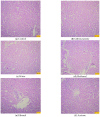Phytochemical Screening, Anti-Inflammatory, and Antidiabetic Activities of Different Extracts from Caralluma edulis Plant
- PMID: 36014583
- PMCID: PMC9412639
- DOI: 10.3390/molecules27165346
Phytochemical Screening, Anti-Inflammatory, and Antidiabetic Activities of Different Extracts from Caralluma edulis Plant
Abstract
The plant Caralluma edulis is traditionally used against diabetes and inflammatory conditions in Pakistan. This study was designed to provide scientific validation of the traditional use of Caralluma edulis. Phytochemicals were extracted from the plant by different solvents (distilled water, methanol, ethanol, and acetone) using the Soxhlet's extraction method. Bioactive compounds were detected by gas chromatography-mass spectrometry (GC-MS). The in vitro anti-inflammatory activities (albumin denaturation, membrane stabilization, and proteinase inhibition) and antioxidant capacity (DPPH scavenging activity, FRAP reducing activity) of different extracts from Caralluma edulis were assessed. The antidiabetic potential of Caralluma edulis plant extracts was determined in acute and subacute diabetic rabbit models. Oxidative stress and enzymatic antioxidant status were also estimated in MDA, CAT, and SOD levels. Results showed that the methanol extract yielded the highest contents of phenolics, flavonoids, alkaloids, and terpenoids. The in vitro anti-inflammatory activity and antioxidant potential of the methanol extract were the highest among the tested solvents. The tested extracts did not show any remarkable antidiabetic activity in the acute diabetic model. However, all tested extracts demonstrated antidiabetic potential in the subacute diabetic model. No adverse effect was observed at the tested dose (200 mg/kg) of Caralluma edulis extracts in experimental animals. It is concluded that methanol is the key solvent for extracting bioactive compounds from Caralluma edulis. The plant can be used against inflammatory disorders and may prove a potential candidate for drug development. Long-term use of Caralluma edulis at the tested dose (200 mg/kg) showed antidiabetic properties in the animal model.
Keywords: Caralluma edulis; GC-MS analysis; anti-inflammatory; antidiabetic; antioxidant; phytochemical screening; rabbits.
Conflict of interest statement
The authors declare no conflict of interest.
Figures




Similar articles
-
Caralluma edulis (Apocynaceae): A Comprehensive Review on its Traditional Uses, Phytochemical Profile and Pharmacological Effects.Curr Top Med Chem. 2022;22(18):1501-1514. doi: 10.2174/1568026622666220527092825. Curr Top Med Chem. 2022. PMID: 35638276 Review.
-
Caralluma tuberculata N.E.Br Manifests Extraction Medium Reliant Disparity in Phytochemical and Pharmacological Analysis.Molecules. 2021 Dec 13;26(24):7530. doi: 10.3390/molecules26247530. Molecules. 2021. PMID: 34946613 Free PMC article.
-
A Comparative Study of Diospyros malabarica (Gaub) Extracts in Various Polarity-Dependent Solvents for Evaluation of Phytoconstituents and Biological Activities.Biomed Res Int. 2022 Jun 25;2022:4746223. doi: 10.1155/2022/4746223. eCollection 2022. Biomed Res Int. 2022. PMID: 35789643 Free PMC article.
-
Phytochemistry, Biological, and Toxicity Study on Aqueous and Methanol Extracts of Chromolaena odorata.ScientificWorldJournal. 2023 Oct 9;2023:6689271. doi: 10.1155/2023/6689271. eCollection 2023. ScientificWorldJournal. 2023. PMID: 37849963 Free PMC article.
-
Caralluma europaea (Guss) N.E.Br.: A review on ethnomedicinal uses, phytochemistry, pharmacological activities, and toxicology.J Ethnopharmacol. 2021 Jun 12;273:113769. doi: 10.1016/j.jep.2020.113769. Epub 2021 Jan 4. J Ethnopharmacol. 2021. PMID: 33412248 Review.
Cited by
-
Exploring the antidiabetic potential of Octhochloa compressa: a comprehensive study on chemical profiling, in vitro, in vivo and in silico pharmacological properties.Front Pharmacol. 2025 May 20;16:1541482. doi: 10.3389/fphar.2025.1541482. eCollection 2025. Front Pharmacol. 2025. PMID: 40463898 Free PMC article.
-
Chemical Composition Analysis and Assessment of Antioxidant and Anti-Inflammatory Activities of Crude Extract of Flueggea leucopyrus on Carrageenan-Induced Paw Edema in Wistar Albino Rats.Antioxidants (Basel). 2024 Aug 12;13(8):976. doi: 10.3390/antiox13080976. Antioxidants (Basel). 2024. PMID: 39199223 Free PMC article.
-
Exploring the therapeutic potential of Caralluma fimbriata for antioxidant and diabetes management: a 28-day rat model study.Toxicol Res (Camb). 2024 Jul 1;13(4):tfae094. doi: 10.1093/toxres/tfae094. eCollection 2024 Aug. Toxicol Res (Camb). 2024. PMID: 38957782 Free PMC article.
-
The impact of Caralluma munbyana extracts on Streptococcus mutans biofilm formation.Front Dent Med. 2025 Jun 4;6:1575161. doi: 10.3389/fdmed.2025.1575161. eCollection 2025. Front Dent Med. 2025. PMID: 40535507 Free PMC article.
References
-
- Malladi S., Ratnakaram V.N., Babu K.S., Sreenivasulu M. Pharmacological Review of Caralluma r.br: A Potential Herbal Genus. Asian J. Pharm. 2018;12:S1146
-
- Patel A.K., Phulwaria M., Rai M.K., Gupta A.K., Shekhawat S., Shekhawat N. In vitro propagation and ex vitro rooting of Caralluma edulis (Edgew.) Benth. & Hook. f.: An endemic and endangered edible plant species of the Thar Desert. Sci. Hortic. 2014;165:175–180. doi: 10.1016/j.scienta.2013.10.039. - DOI
-
- Priya D., Rajaram K., Suresh Kumar P. Phytochemical studies and GC-MS analysis of Caralluma fimbriata Wall. Int. J. Pharm. Res. Dev. 2011;3:105–110.
MeSH terms
Substances
LinkOut - more resources
Full Text Sources
Medical
Miscellaneous

